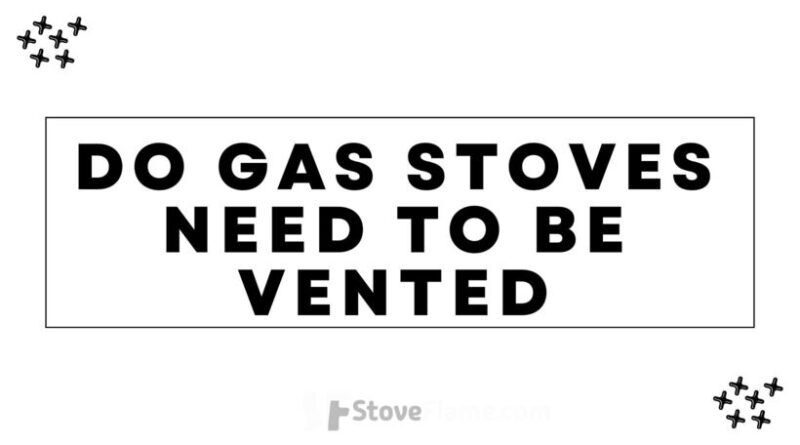Do Gas Stoves Need To Be Vented?
Gas stoves have long been a staple in kitchens around the world, providing a reliable and efficient means of cooking food. However, as with any type of fuel-burning appliance, there are important safety considerations to keep in mind.
One of the most frequently asked questions among homeowners and renters alike is whether gas stoves need to be vented. The answer to this question is not a simple yes or no, as it ultimately depends on the specific type and installation of the gas stove.
In this article, we’ll discuss the significance of venting gas stoves, the various venting options accessible, and why having proper ventilation is vital for the safety and health of your household. Whether you’re looking to buy a new gas stove or want to ensure the safety of your current one, grasping the importance of correct venting is crucial. Let’s take a closer look at gas stove ventilation and uncover the key facts you should be aware of.
How Gas Stoves Work?
Gas stoves work by utilizing a combination of fuel, air, and ignition to create a controlled flame that heats up the cookware. The key component of a gas stove is the gas burner, which contains small holes where the gas is released. When the stove is turned on, the gas flows through the burner, and the control knobs allow the user to adjust the amount of gas being released. The gas is then mixed with air and ignited by a pilot light or an electric spark.
As the gas burns, it produces a steady flame that heats the cookware placed on top of the burner. The heat is transferred from the flame to the cookware, allowing for efficient and precise cooking.
It’s important to note that gas stoves require a reliable source of natural gas or propane to function properly. Regular maintenance and periodic inspections are also recommended to ensure the safety and efficiency of the stove.
Types of Gas Stoves
There are several different types of gas stoves available on the market, each with its own unique features and benefits. One popular type is the freestanding gas stove, which is a standalone unit that can be placed anywhere in the kitchen. These stoves typically have a built-in oven as well, providing versatile cooking options.
Another option is the slide-in gas stove, which is designed to fit seamlessly between kitchen countertops and cabinets, giving a sleek and integrated look.
Built-in gas stoves are another choice, which are installed directly into the kitchen cabinetry for a seamless and streamlined appearance. Finally, there are portable gas stoves, which are lightweight and compact, making them ideal for camping trips or outdoor cooking. Whether you prefer a freestanding, slide-in, built-in, or portable gas stove, there is a perfect option to suit your cooking needs and kitchen style.
Do Gas Stoves Need to Be Vented?
If you own a gas stove, you may be wondering if it needs to be vented. The answer depends on the type of gas stove you have and the ventilation system in your kitchen. Freestanding and slide-in gas stoves usually don’t require a venting system since they have a built-in ventilation system that directs the fumes outside. However, it’s important to ensure that the ventilation system is functioning properly and regularly cleaned to maintain efficient airflow.
On the other hand, built-in gas stoves and portable gas stoves may require a separate ventilation system installed in your kitchen to effectively remove any harmful gases. It’s recommended to consult the manufacturer’s guidelines or a professional to determine the ventilation requirements for your specific gas stove model to ensure safety and proper functioning.
Types of Ventilation Systems
When it comes to ventilation systems, there are various types available to suit different needs and kitchen setups. One common type is the overhead range hood, which is mounted above the gas stove and uses a fan to pull cooking fumes and smoke up and out of the kitchen. These range hoods can be vented externally, directing the air outside, or can be ductless, where they use filters to capture and recirculate the air back into the kitchen.
Another type is the downdraft ventilation system, which is usually installed directly into the countertop or behind the cooktop. This system pulls the air downwards and either vents it outside or filters it and recirculates it.
Additionally, some kitchens may have a combination of both overhead range hoods and downdraft systems for maximum ventilation efficiency. Ultimately, the choice of ventilation system depends on factors such as kitchen layout, personal preferences, and the specific requirements of your gas stove.
How to Properly Vent a Gas Stove?
To properly vent a gas stove, there are a few key steps to follow. First, ensure that the gas stove is positioned in a well-ventilated area. This means having sufficient airflow and access to an exhaust system, such as a range hood or downdraft ventilation system. It is important to check if the existing ventilation system is in good working condition and properly connected to the gas stove.
Next, consider the type of ventilation system that best suits your kitchen setup. As mentioned earlier, overhead range hoods are commonly used to pull cooking fumes and smoke up and out of the kitchen. These hoods can be vented externally or operate with filters for recirculation. Downdraft ventilation systems, on the other hand, are installed directly into the countertop or behind the cooktop and pull air downwards, either venting it outside or filtering it for recirculation.
Once you have the appropriate ventilation system in place, make sure to clean and maintain it regularly. Filters should be replaced or cleaned according to the manufacturer’s instructions to ensure optimal performance.
Additionally, keeping the area around the gas stove clean and free from grease buildup will help maintain proper airflow and ventilation.
Remember, proper ventilation is crucial for gas stoves to remove any potentially harmful combustion byproducts, such as carbon monoxide, and to maintain a safe and healthy cooking environment. By following these steps and regularly maintaining your ventilation system, you can ensure that your gas stove is properly vented and operating efficiently.
Why Proper Ventilation is Necessary?
Proper ventilation is necessary in any kitchen, especially when it comes to using gas stoves. Without adequate ventilation, the byproducts of gas combustion, such as carbon monoxide and other harmful gases, can accumulate in the air and pose serious health risks. These gases can lead to symptoms like headaches, dizziness, nausea, and even carbon monoxide poisoning in extreme cases.
Additionally, cooking with gas stoves produces smoke, steam, and cooking odors, which can create a stuffy and uncomfortable environment if not properly ventilated. By ensuring proper ventilation, you not only improve the air quality in your kitchen, but also create a safer and more pleasant cooking experience for you and your family.
Signs of Inadequate Ventilation
If you notice a persistent and unpleasant odor lingering in your kitchen even after cooking, it may be a sign of inadequate ventilation. Poor ventilation can cause cooking odors to stick around, making the air feel stale and heavy.
Another common sign is the presence of condensation on windows and walls, especially during and after cooking. This moisture buildup occurs when the hot, moist air from cooking cannot escape properly, leading to potential mold and mildew growth.
Additionally, if you find yourself frequently experiencing respiratory issues such as coughing or difficulty breathing while cooking, it could be a result of inadequate ventilation. These signs indicate the importance of ensuring proper ventilation in your kitchen to maintain a healthy and comfortable environment.
Location of Vent
When it comes to the location of the vent for your gas stove, it is crucial to consider both safety and functionality. Ideally, the vent should be positioned above the stove to effectively capture and remove any fumes, smoke, and airborne particles produced during cooking. This placement allows for proper ventilation and prevents these pollutants from spreading throughout your kitchen and home.
Additionally, having the vent above the stove helps to minimize the risk of grease buildup on surfaces and appliances, reducing the chances of a potential fire hazard. So, when designing or renovating your kitchen, be sure to prioritize the location of the vent to ensure optimal ventilation and a safe cooking environment.
Cleaning and Maintenance Tips
Regular cleaning and maintenance of your gas stove is essential for both its performance and longevity. To keep your stove in top condition, it’s recommended to clean the burners and grates regularly with warm soapy water and a non-abrasive sponge. Remove any stubborn stains or residue using a mixture of baking soda and water. Avoid using harsh chemicals or abrasive cleaners that can damage the surface of the stove.
Additionally, remember to clean the oven regularly and remove any food spills or grease buildup to prevent unpleasant odors and potential fire hazards.
Lastly, don’t forget to periodically check and clean the ventilation system to ensure proper airflow and prevent any blockages. By following these cleaning and maintenance tips, you can enjoy a clean and efficiently functioning gas stove for years to come.
When to Call a Professional?
If you have followed all the cleaning and maintenance tips mentioned above and are still experiencing issues with your gas stove, it may be time to call a professional. While regular maintenance can help prevent common problems, there are certain issues that require the expertise of a trained technician.
If you notice a persistent gas odor, unusual sounds, inconsistent heating, or difficulty igniting the burners, it is advisable to seek professional assistance. Gas appliances can be potentially dangerous if not handled properly, so it is best to rely on a qualified technician who can diagnose and fix the problem safely.
Remember, when it comes to the safety and functionality of your gas stove, it’s always better to be cautious and seek professional help when needed.
Conclusion
In conclusion, while it may seem like a hassle or an unnecessary expense, properly venting your gas stove is crucial for the safety and well-being of yourself and your household. Not only does it remove harmful pollutants from your home, but it also helps to prevent potential fire hazards.
If you currently have an unvented gas stove, it is highly recommended to have it professionally converted to a vented one. By taking this step, you can enjoy cooking on your gas stove without worrying about the negative consequences of not having proper ventilation. Your health and safety are important, so don’t overlook the importance of properly venting your gas stove.
I'm Daniel Miller, the proud owner of StoveFlame. With over five years of experience in this dynamic field, I've honed my skills and passion for delivering top-notch quality and accuracy in everything I do.





